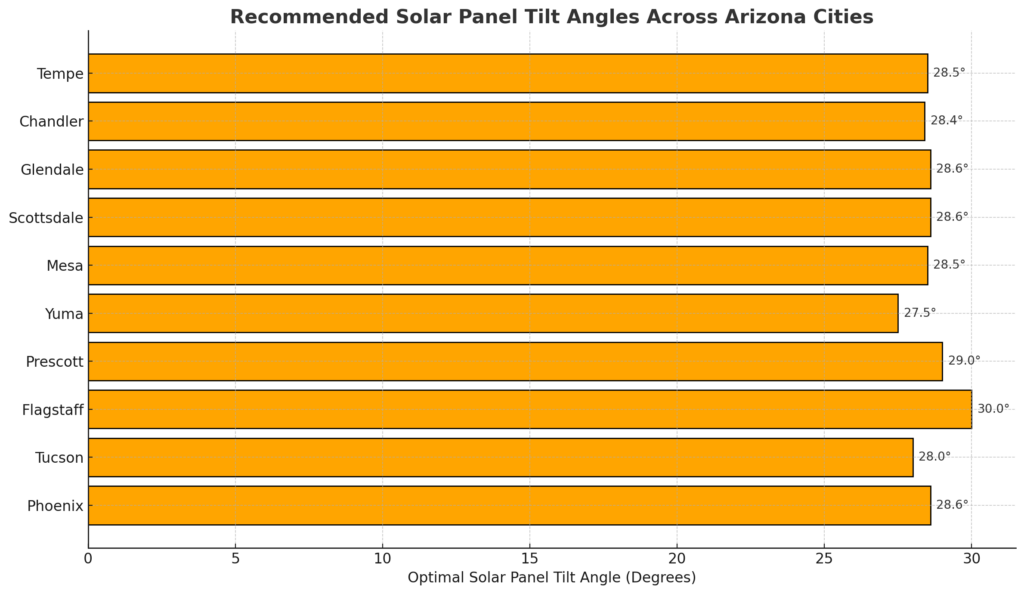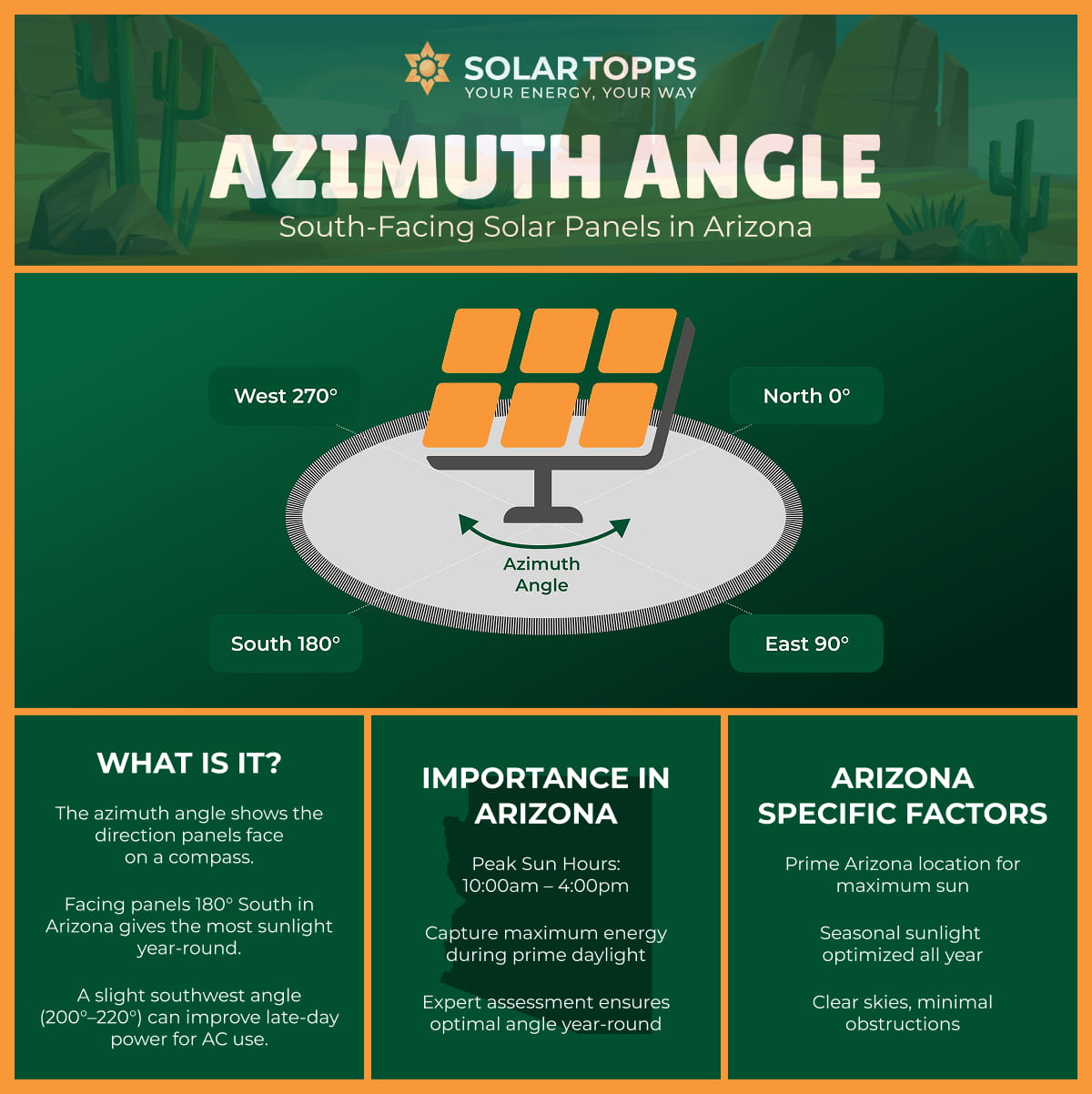What is the Best Angle for Solar Panels in Arizona?
What is the Best Angle for Solar Panels in Arizona?
Updated: October 22, 2025
The Bottom Line: Best Angles for Solar Panels
For most homes in Arizona, south-facing solar panels tilted at 15–40° offer the best overall performance. But don’t stress if your roof faces east or west — you can still generate substantial solar energy and significantly reduce your electric bills. When determining the optimal setup for your solar panels, several factors come into play beyond orientation and tilt angle. Shade considerations are crucial, as shadows from nearby trees, buildings, or other obstructions can impact energy production. The type and efficiency of the solar panels themselves can influence performance, with higher-efficiency panels often delivering better results in less-than-ideal conditions. Lastly, understanding your home’s energy consumption patterns will help ensure your system is properly sized to meet your needs while maximizing your return on investment.
At Solar Topps, we service the entire state of Arizona. However, as we are located in Downtown Phoenix, we also specialize in cities like Scottsdale, Paradise Valley, Mesa, Chandler, Eloy, Buckeye, Tolleson, Gilbert, and the entire Phoenix Metro Area.
If you want to go Solar, please Contact Us. You can also fill out a Commercial or Residential Quote.
Solar Panel Angle: Where Should They Point?
When it comes to getting the most from your solar panels, orientation matters. In the U.S., panels that face true south receive the most sunlight throughout the day. According to the U.S. Department of Energy, south-facing panels optimize total solar exposure, especially in the Northern Hemisphere.
If your roof isn’t perfectly aligned to true south, no worries. Southeast and southwest-facing systems can still perform extremely well, with only a slight reduction in output (typically less than 10%).
East vs. West Vs. South vs. North-Facing Solar Panels: What’s the Difference?
Your daily energy habits matter. If your home consumes the most electricity at certain times of the day, orientation can play a key role.
- East-facing Solar panels: Produce more power in the morning — great for early risers and morning-heavy usage.
- West-facing Solar panels: Best for afternoon and evening energy demands — perfect for families who return home and crank up the AC.
- South-facing panels: Optimal for overall energy production throughout the day, especially in areas near the equator. South-facing panels receive the most direct sunlight and can produce the highest amount of power.
- North-facing panels: While not as efficient as other orientations, north-facing panels can still generate a significant amount of energy, making them a viable option for homes with limited roof space or alternative configurations.
In areas with time-of-use billing plans (like those from APS or SRP), west-facing panels may even yield higher financial savings by producing energy during peak billing hours.
When considering panel orientation, it’s important to also take into account any potential obstructions such as trees or nearby buildings that may block sunlight. It’s recommended to consult with a solar installer to determine the best placement for your specific location and usage needs.
True South vs. Magnetic South: A Quick Pro Tip
“True south,” which solar engineers use to position your system, differs from the “magnetic south” shown on a compass. In Arizona, true south is typically 8–12° east of magnetic south. No need to worry — our Solar Topps professionals use GPS, sun path modeling, and solar pathfinders to ensure precise system alignment.
Why South-Facing Panels Are Ideal
South-facing solar panels are considered optimal in the United States because they receive the maximum amount of sunlight throughout the day. This orientation takes advantage of the sun’s arc from east to west, particularly in the southern sky, resulting in greater energy production. By maximizing sunlight exposure, south-facing systems enhance overall efficiency and reduce energy costs over time.
Adjusting for Regional Variations
While south-facing panels are generally ideal, regional factors such as latitude, climate, and shading conditions can impact their effectiveness. For example, areas with shorter daylight hours in winter may benefit from slight orientation adjustments to capture low-angle sunlight. A professional assessment ensures that panel alignment is tailored to meet these regional demands while maintaining high energy output.
What is the Azimuth Angle for South-Facing Solar in Arizona?
Solar panel orientation is critical for photovoltaic system efficiency and performance. Proper alignment maximizes sunlight exposure, optimizing energy production. For Arizona, understanding and adjusting the azimuth angle is key, especially for south-facing solar panels, which offer superior energy capture in the region.
Importance of the Azimuth Angle in Arizona
The azimuth angle significantly influences solar panel efficiency. For Arizona installations, particularly those facing south, this angle dictates the panel’s direction relative to true south. Panels correctly aligned to the optimal azimuth angle will maximize solar exposure, directly increasing energy production. Even minor deviations can lead to reduced efficiency and diminished system output.
Optimizing Azimuth Angle for Arizona Performance
Achieving peak performance requires careful consideration of Arizona-specific factors when setting the azimuth angle. These include geographic location within the state, seasonal sunlight variations, and potential obstructions such as local topography or existing structures. Professional evaluations are essential to determine and maintain the ideal azimuth angle, ensuring the solar system operates at its highest efficiency throughout the year, delivering consistent, reliable energy.
Solar Panel Angle: Getting the Perfect Tilt
The angle of your solar panels is just as important as the direction they face. Panels that are too flat won’t absorb enough sunlight in winter. Panels that are too steep underperform in summer.
A good rule of thumb: tilt = latitude. For most of Arizona, that means around 33°.
According to NREL, adjusting panel tilt even slightly can improve performance by up to 5%, particularly in systems without tracking.
Factors That Affect Your Ideal Angle
Roof Pitch:
- Low pitch (4/12): May require tilt racks to optimize sun exposure.
- Medium pitch (6/12): Often aligns naturally with Arizona’s latitude.
- Steep pitch (9/12): Frequently requires no adjustment.
Your Arizona Location:
- Phoenix / Tucson: Best performance with a 30–33° tilt
- Flagstaff / Northern Arizona: Use 35–40° to compensate for the lower sun angle in winter
Seasonal Sun Angles:
- Summer: The sun sits higher in the sky — a flatter tilt (15–20°) captures more energy.
- Winter: A steeper tilt (40°) improves performance when the sun is lower.

Flat Roof? No Problem for the Best Angle for Solar Panels
Flat roofs are common in Arizona and are excellent candidates for solar. With the right mounting systems, we can tilt your panels at 15–30°, which helps maximize production and minimizes dirt or water accumulation.
This is especially valuable during Arizona’s monsoon season, when keeping panels clean is essential for maintaining output.
Importance of Proper Ventilation and Airflow
When installing solar panels on flat roofs, maintaining proper ventilation and airflow around the panels is crucial. Adequate airflow helps in reducing heat buildup, which can negatively impact the performance of solar panels. By using elevated mounting systems, our team ensures that your panels remain cool and efficient throughout Arizona’s intense summer months, enhancing their overall energy production.
Customizable Solutions for Maximum Efficiency
Every flat roof is unique, and solar panel angles should be adjusted depending on the roof’s orientation and shading patterns. Our customizable mounting systems allow us to create tailored solutions that optimize energy production for your specific roof. Whether your roof faces partial shading or has unconventional dimensions, we design angles that guarantee reliable and efficient energy generation year-round.
Most Arizona Roofs Are Solar-Suitable — Including Yours
According to the National Renewable Energy Laboratory (NREL), over 80% of buildings in the U.S. are solar-suitable, and Arizona homes are no exception.
Even if your roof isn’t perfectly tilted or oriented, the right system can:
- Lower your electric bill every month
- Pay for itself in just a few years
- Provide 25+ years of clean, renewable power
What Matters for Solar Success in Arizona
While direction and angle matter, they’re not the only considerations that affect system performance. Our 15+ years of experience as an Arizona Solar Installer has shown us that the following often matter more:
- Shading from trees, chimneys, or nearby buildings can dramatically reduce production.
- Roof size and layout determine how many panels we can install — you’ll need enough space for at least 8–10.
- Roof condition matters too. Older or damaged roofs may need upgrades before installation.
At Solar Topps, we evaluate all these variables when designing a system tailored to your home.
Ready to See What Solar Can Do for You?
Our free solar evaluation includes:
- A custom roof and shading analysis using industry-grade solar modeling software
- An energy usage breakdown and how much solar can offset
- A custom design showing expected energy production
- A complete financial model with your ROI, payback period, and eligible incentives
The Solar Topps Difference when finding the Best Angle for Solar Panels
At Solar Topps, we’re not in the business of pushing panels — we’re in the business of making solar make sense.
We’ve helped thousands of homeowners across Arizona make the switch to clean, affordable energy. If solar isn’t a good fit for your home, we’ll say so. If it is, we’ll design a system that actually saves you money — with zero pressure.
Call us today at (480) 940-1201
schedule your free solar evaluation












